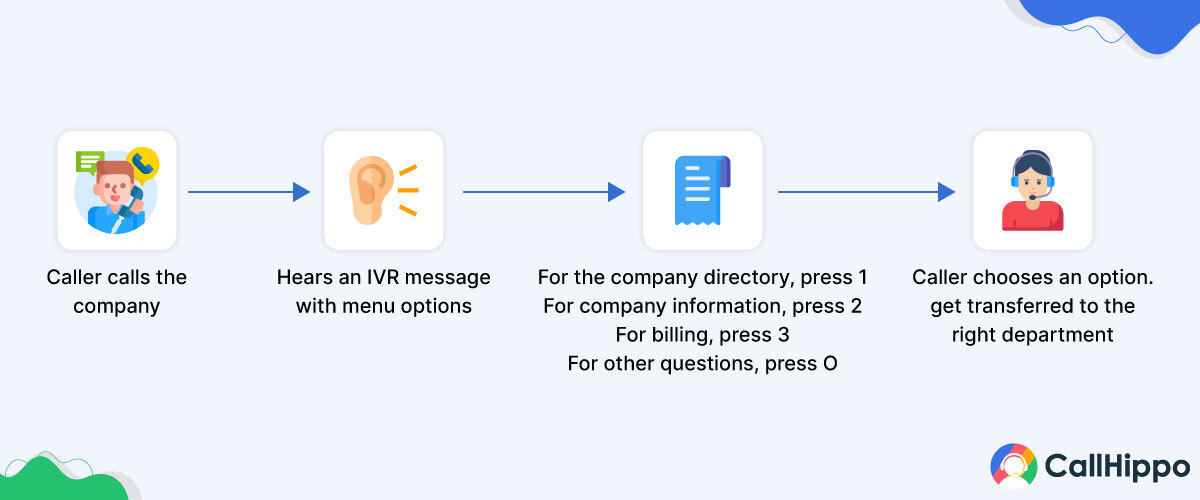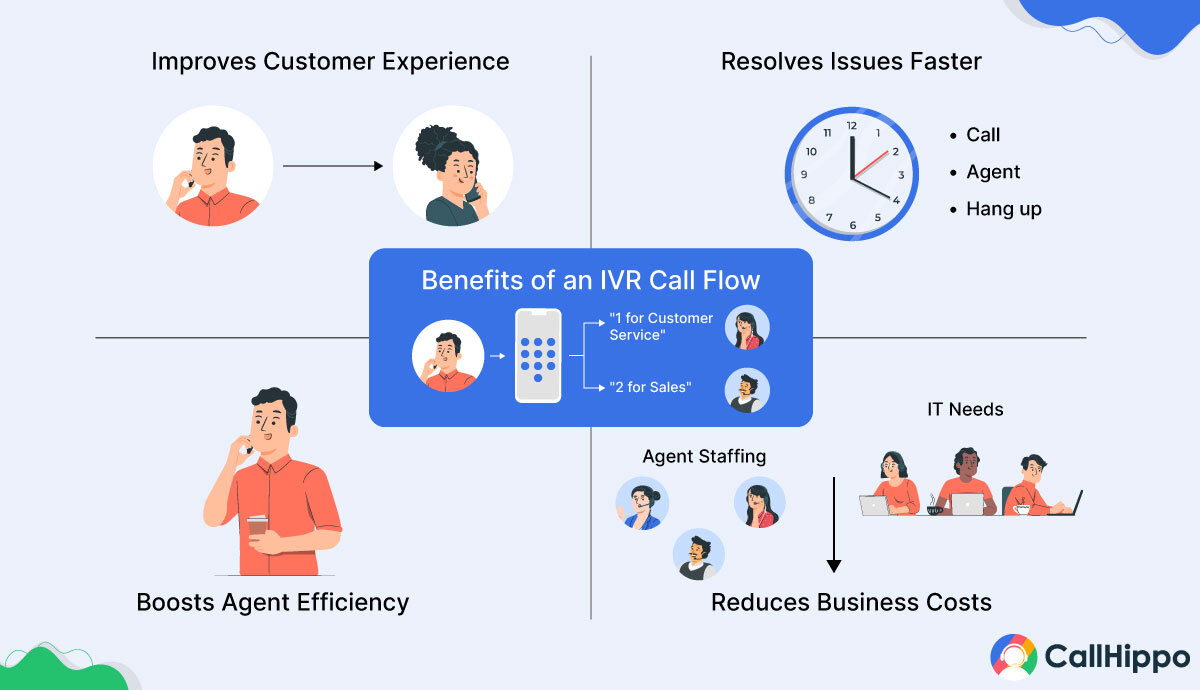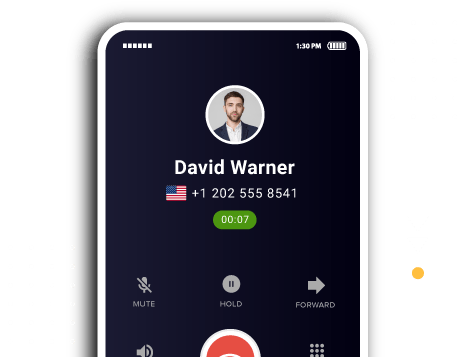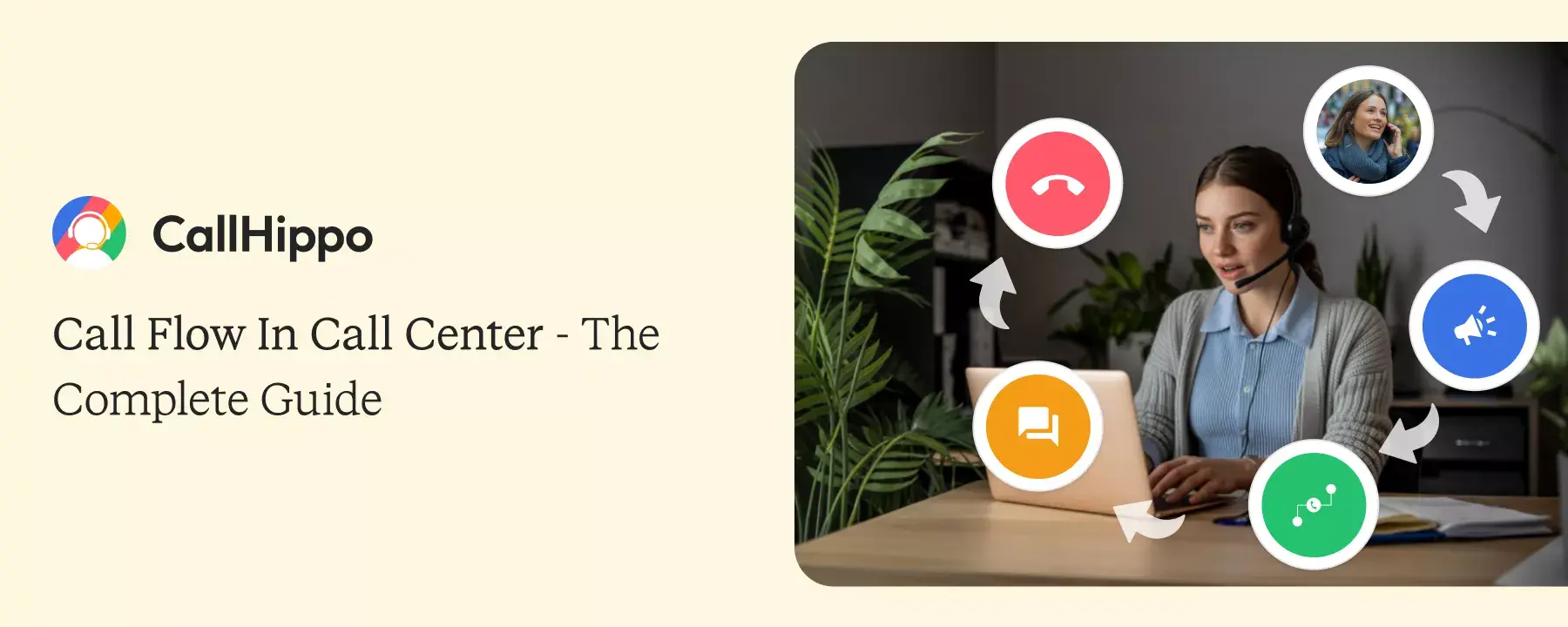Modern businesses and their customers are far different than what they were a decade ago. Today’s businesses strive to excel in customer support to build strong, long-lasting relationships with their customers. But amidst the flurry of inbound calls, the undefined structure and flow of the conversations often leave customers frustrated. In fact, according to research, 52 per cent of customers will switch to a competitor if they have a single negative experience. A well-defined call flow for customer service can help businesses overcome this problem.
In this blog, we will go through the basics of call flow in call centers, exploring its importance, types, challenges, and more to help businesses master this crucial aspect of customer service.
What Is a Call Flow?

A call flow is a pathway through which your customers make their way into your call center when they dial in. It helps ensure a seamless journey for your customers from the beginning to the end of the call. A clearly defined call flow also helps your customers get connected to the right customer service agent or department as quickly as possible.
The perfect customer service call flow must include accurate instructions in the form of directions, messages, or self-service options to guide customers from the moment their call gets connected. It also includes the right steps for customer service agents to resolve problems after customers connect with them. These involve greetings, problem inquiry, resolution, and so on.
Call flow for call center can be simple or complex. For example, the simplest one is where the contact center representative directly greets the dialer, and the complex one involves an array of options provided by an IVR. In complex call flows, the dialer chooses a relevant option from the menu, such as connecting to an agent, knowing your account details, changing your password, etc.
Ensure a streamlined call flow for your call center to improve the customer experience and resolve issues faster. Invest in the right virtual phone system software to implement the right steps for seamless call flow to improve operations and agent efficiency.
Why is Call Center Call Flow Important?

Call flow plays a major role in customer service success. Call flow empowers your customers to receive quick assistance without swinging between agents and departments. It saves your customers valuable time by sending them in the right direction. Since call flows assist agents in providing prompt resolution, they can help your call center make a great first impression about your services, boost customer satisfaction, and improve customer loyalty, which are pivotal in today’s competitive business landscape.
Call flows are equally important for your call center and its agents, as they have a direct impact on certain call center metrics. They give them step-by-step guidance to handle customer queries more efficiently. A proper call flow can reduce call hold time, average handling time, call length, repeat calls, etc., in your call center. Plus, advancements like IVR and automated routing in your call flow can further resolve major customer service problems like busy lines and redirected calls.
Overall, call flows enhance the operations of your call center through effective resource allocation, optimized workflows, and improved agent performance.
How to Design an Effective Call Flow for Customer Service?
A good call center call flow process starts when you understand what customers expect and what your team can deliver. In this call center guide, let’s walk through the steps that help you build one that actually works.
1. Mapping the Customer Journey Through the Call Flow
Start by looking at how a customer moves from the first ring to the final resolution. You will clearly understand where they actually get stuck. Also, it will help you smooth out those points.
Then, map each stage in a simple order. Keep each path very clean. And make sure that every step brings the caller closer to a solution. This keeps your service predictable and easy to follow.
2. Including Branches for Common Scenarios (escalations, transfers, callbacks)
You can add small branches for situations that happen frequently. These include escalations, transfers, or callback requests. It’s important that each branch is simple, because it should guide the caller without confusion.
Also give your agents clear instructions for each branch. This keeps the response time steady. It also builds trust because callers get the right help every time.
3. Integrating IVR, ACD, and Agent Scripting
Use tools like IVR and ACD to route calls based on the caller’s needs. It reduces the wait time and also helps agents to actually understand the context before they talk to the customer.
You can also add short scripts for your agents, which will guide them at each point. Scripts keep the entire conversation polite and helpful throughout. When all tools work together, the call flow feels smooth.
4. Using Metrics & Feedback to Optimize Your Call Flow
Look at metrics like wait time and first call resolution. These numbers tell you where people struggle. They also show areas where your agents do well.
Then use this customer feedback to improve the call center call flow. It shows you what the system feels like for real callers. Small changes based on feedback can make a big difference.
- Your team can move calls across any number of departments.
- Callers reach the right team without extra wait.
- Agents solve issues faster as there is the right expert at each step.
What Are the Types of Call Flows in a Call Center?
Every call flow process in call center has different kinds of conversations to handle. That’s why each one needs a flow that matches the purpose of the call.
1. Inbound Call Flow
An inbound flow guides your team when customers call you for help. It covers steps like greeting, identifying the issue, and moving toward a solution. A clear flow reduces wait time. And it also helps your agents to stay confident because they always know what to do next.
2. Outbound Call Flow
When your team reaches out to customers, outbound call flows come into place. These calls can be sales calls or follow ups. The flow helps your agents start the call in a warm way. Then it guides them through the key steps. These can include sharing information and closing the call with clarity. This keeps the whole conversation smooth and flowing.
3. IVR Call Flow
In an IVR flow, callers can choose what they need through the simple menu options. It also helps you route calls based on their choices. This cuts the load on your agents. A good IVR flow stays short. It only shows options that matter so the callers are kept away from getting lost or confused.
with CallHippo IVR
- 1Simple IVR
- 2Fewer repeats
- 3Fast answers
- 4Smooth routing

A. After Hour Call Flow
An after hour flow handles the calls that come in when your team is offline. It shares helpful information like business hours or callback options. It can also route urgent cases to a backup line. This makes sure that no critical call is missed. And most importantly, it keeps your customers always informed even when your office is closed.
B. Blended Call Flow
A blended flow works for teams that handle both inbound calls and outbound calls. Agents can switch between the two very easily. This type of flow balances the workload. It also makes sure that every call gets the right attention. Your team throughout the day stays productive.
C. Closing Call Flow
A closing flow guides the agents on how to end a call on a positive note. It includes the solution and shares any next steps. It also reminds agents to thank the customer, which ultimately leaves a good final impression and shows that you value their time.
D. Routing Automation Flow
Routing automation flows decide where a call should go based on rules that you set. Now these can be skills, priorities, or the history of the caller. This flow reduces guesswork for agents, which also improves speed because every call reaches the right place. It keeps the overall experience simple for the caller.
E. System or Queue Flows
System or queue flows control what happens while a caller waits in line. You can guide them with short updates or empathy statements . This keeps them informed and calm. You can also offer simple self-help options during this time, which gives callers a sense of control. Along with this, your queue remains light and easy for your team to handle.
Examples of Call Flow in Call Center
Let’s look at a few real examples of how call center call flows work in day-to-day situations:
1. Call Flow in Customer Service
A customer service call flow starts when a caller shares their issue. Your agent listens and asks a few quick questions. This helps them understand the problem more clearly.
Then the agent follows the next steps in the flow. They share the solution or route the call to an expert. The goal is to close the issue with care and speed.
- A caller says that their call recordings are not showing in the dashboard. The agent then checks the recent activity and confirms a sync delay. He then runs a quick refresh from the backend. The recordings appear again, and the agent explains further how to avoid this issue in the future.
2. Call Flow in Sales
You always begin a sales flow with a warm greeting. Your agent sets the tone and builds a small connection, which makes the caller feel comfortable.
Next, the agent shares the value of the product in simple points. They answer questions and guide the caller toward a clear next step, which keeps the sales call confident and steady.
- Suppose that a clinic wants a phone system to handle appointments for its patients. The agent then asks about the staff size and call load. Then they explain features like multi-level routing and after hours flows. The clinic books a demo immediately.
3. Call Flow in Lead Qualification
When you want to know if your caller is a good lead or not, a lead qualification flow helps you find that. Agents ask short questions about the needs and budget. This keeps the call focused and easy to follow.
And once the agent understands the fit, they choose the next step. It may be a demo or a follow up. This flow saves time for both the agent and the caller.
- A caller wants to know the pricing for a cloud phone system. The agent asks about the team size and daily call volume. They confirm the caller needs analytics and multi-level routing. The agent then marks them as a high-value lead and books a demo with the sales team.
How to Map Your Call Flow for Busy Hours and Peak Call Times?
Peak hours can be stressful for your team. A clear call center call flow helps you stay in control and handle every call with ease.
1. Identify Common Call Types During High Traffic
First, check that during the rush hours, which calls do you receive the most? These could be support requests or order issues. This helps you understand where your callers need the most help. Then group these calls into simple categories. It gives you a clean picture and also helps you build a flow that fits the real needs of your callers.
2. Prioritize Routing for Urgent or High-Value Calls
There are some callers who need quick attention. These may be billing issues or escalations. You can mark these calls as priority so they move ahead in the queue.
With the call routing feature you can set simple rules that send priority calls to skilled agents. This reduces the wait time and also keeps important customers happy during the peak hours.

Connect calls faster with smart routing, zero chaos and keep your callers happy
1. Set Up Overflow Queues and Backup Agents
Overflow Call queues help you handle extra calls when your main team is busy. Callers wait in a separate line. They also get any short updates, so they stay informed. You can assign your backup agents to these queries. This would keep the load balanced and also stop your team from feeling rushed or overwhelmed.
2. Use Automation and IVR to Handle Routine Queries
Automation handles simple questions like order status or account details. This removes repeat tasks from your agents and also helps the callers get answers fast. An IVR can guide the caller with quick menu options. It reduces pressure on your main queue and also keeps the experience smooth during high traffic.
3. Monitor and Adjust Your Call Flow in Real Time
Peak hours can change fast. It helps when you watch call metrics in real time. These numbers show you exactly where the delays are happening. Once you see a pattern, adjust your flow quickly. You can add agents or change routing. Small changes like this make a big difference during the busy periods.
How to Use Customer Behavior Insights to Improve Call Flow?
When you know how callers behave, you can shape a call flow that feels natural and easy for them to follow. Let’s see how you can utilize the customer behaviour insights to improve the basic call flow in call center:
1. Track Drop-Off Points in the Current Call Flow
Start by checking where callers leave the flow. You may notice drops at long menu options or during long wait times. These patterns show you where callers feel stuck. Then make small fixes in those areas. You can also shorten a step or add clearer prompts. Every improvement helps callers stay with the flow until the end.
2. Personalize Routing Based on Customer History
Customer history can guide the routing decisions. You can check past issues or recent tickets, which tell you what the caller needs before the call starts. Once the system knows this, it routes the call to the right team. This reduces repeated questions and also makes the conversation smoother for both sides.
3. Segment Callers by Behavior, Location, or Value
Callers behave differently based on use case or region. You can group them into simple segments. This helps you understand what each group expects. Then create small routing rules for each segment. It keeps the flow relevant and also makes sure that callers of high value get quick attention.
4. Use Feedback and Post-Call Surveys to Refine Scripts
Caller feedback is a strong signal. It tells you what feels helpful and what feels confusing. And short Post Call surveys work perfectly for this. When you spot a pattern, update your scripts. You can simplify a question or add a new step, which would keep your flow fresh and more aligned with real needs.
5. Leverage Analytics Tools (like CallHippo) to Optimize Call Paths
Analytics tools show you call patterns in real time. You can see wait times, transfers, and the completion rates. These numbers reveal how your flow performs.
CallHippo, one of the best call center software, gives you clear dashboards that highlight bottlenecks and peak load hours. This makes it easy to adjust the call path with confidence. The data ultimately shows where to improve and also helps your team handle calls in a steady and predictable way.
What are the Common Challenges in Call Flow?
Several challenges may come across designing, using, and optimizing the call flows for call center. Learning about these challenges and keeping them in mind when implementing call flows for call center might help you overcome them. Here are some of the common challenges in call flow:
1. Agent Training
Ensuring consistency and proficiency among agents may be challenging, especially in the call flows of large teams or complex call environments. Therefore, it is crucial to provide comprehensive, ongoing, and tailored training sessions to address specific call flow scenarios and customer needs.
2. Personalization
Although personalized call flows for call center can help deliver great customer experiences, maintaining consistency with them can be challenging. Challenges like outdated or incompatible systems, lack of automation capabilities, and constraints in customization may hinder the implementation of a seamless call flow process when using call center technology.
3. Technological limitations
Call center operations greatly rely on technology, which can again come with its own challenges. When using call center technology, challenges like outdated or incompatible systems, lack of automation capabilities, and constraints in customization may hinder the implementation of a seamless call flow.
Conclusion
Having a well-defined call flow for customer service plays a major role in your contact centers’ success. A good call flow contributes to effective customer support management and helps your agents deliver top-notch customer support. Now that you know the importance, types, and challenges of call flow, take the right step by creating an effective call flow process in your business phone system.
FAQs
1. Is There Any Difference Between Call Flow Script and Calling Flow?
Call center scripts are responses or steps that help call center agents handle common customer issues quickly, whereas a call flow is a blueprint of how a successful conversation on call should flow.
2. What Tools Can Help Improve Call Center Call Flow?
You can improve call center call flow processes by incorporating tools like Interactive Voice Response, Call Management System, Automatic Call Distributor, etc.
3. How Can You Measure the Success of Call Flow Implementation?
The success of call flow implementation can be measured through various key performance indicators (KPIs), such as First Call Resolution (FCR), Average Handling Time (AHT), Customer Satisfaction Rate (CSAT), Call Abandonment Rate, and so on.
4. What is the difference between call flow process and call routing?
A call flow process shows you the full path that a caller goes through. It guides the entire conversation from start to finish.
And call routing basically focuses on sending the call to the right team or the agent. It is one part of the call flow. Routing decides where the call goes. In comparison, the call flow decides what happens after that.

Subscribe to our newsletter & never miss our latest news and promotions.








